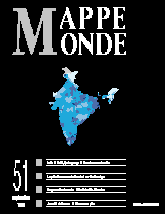

Economic Activities and Territorialisation in India (4 fig.)
This article presents a regional organisation of India based on the mapping of the working population in agriculture, handicrafts and industry in 1991 census data. It points up strong areal differentiation across the country in the current context of free-market reforms, rapid output growth in all sectors and integration into the world economy.
keywords: AGRICULTURE, ECONOMIC GEOGRAPHY, HANDICRAFTS, INDIA, INDUSTRY, REGION
Jean-Marie THÉODAT. Haiti Quisqueya: Double Insularity (1 fig.)
Two countries share an island bisected by a meridional border more than 300 km long : Haiti in the west and Quisqueya in the east. This dichotomy was inherited from the colonial division of the island between France and Spain and continued in the two new nations because of their contrasting spatial dynamics and principles of territorial organisation. This has led to a feeling of double insularity where each country behaves towards its neighbour as though they were located on two separate islands.
keywords: BORDER, INSULARITY, HATO, MADANSARAH, PEPE, TERRENOS COMUNEROS
Snezana PROKIC. Croatia: Tourism before and after the War (5 fig.)
Wars have deeply changed the touristic space of Croatia. In comparison with a touristic space of reference (before 1991), the article emphasizes changes in places, their capacity, the nature and scale of attendance.It identifies logics which interfere with the previous structure.
keywords: ACCESSIBILITY, CONFLICT, CROATIA, LITTORAL, TOURISM
Maryvonne LE BERRE, Joëlle MAILLARDET. On Land and Sea: Spatial Organisation in the North Sea and Norwegian Sea (8 fig.)
By means of cartographic and graphic representations, this article illustrates the spatial structures developed at sea for oil and gas production. Despite the difference in environment, the sea is appropriated and occupied in the same way as the continent, except that installations are arranged vertically at sea, whereas they are spread over the surface of the continent.
keywords: EXCLUSIVE ECONOMIC ZONE, NORTH SEA, NORWEGIAN SEA, OFFSHORE FIELD, OIL, SPATIAL STRUCTURE
Progress in Cartography and the Approach to the City: Moscow and the Culture of Disorientation (2 fig.)
A map of the city of Moscow published in 1997 is an indication of the remarkable progress made in urban cartography in Russia. Producing a workable map is indeed an achievement in a city where the complex arrangement of buildings and lack of signs makes it extremely difficult to find one's way around in the various districts. The publication of this map is evidence of the growing openness of Russian society, which is gradually turning its back on the culture of secrecy.
keywords: CITY MAP, COMPUTER-ASSISTED CARTOGRAPHY, MOSCOW, RUSSIA
Jean-Michel JAUZE. Inversed Centrality on the Island of Reunion (3 fig.)
The spatial organisation of the island of Réunion is characterised by a number of imbalances. Centre and peri-phery are to be interpreted on more than one level to understand the concept of a peripheral «centre» encircling a central «periphery». This particularity results from the application of colonisation, then «departmentalisation», to a mountainous territory.
keywords: CENTRE-PERIPHERY, POLARISATION, REUNION, SPATIAL ORGANISATION, URBANISATION
Patrick BOUCHET, Jean-Christophe GAY. The Highlands of Reunion conquered by Leisure Activities (6 fig.)
In just over a decade, the highlands of Reunion Island have become areas that attract a large number of visitors, both because of increased demand and improved and diversified supply. Too hastily equated with rural tourism, this appropriation is not in fact homogeneous. An analysis of the different activities of visitors reveals a new spatial organisation of the interior of the island.
keywords: LEISURE ACTIVITIES, REUNION, RURAL AREA, SPORT, TOURISM
Joël PAILHÉ. Jazz, Globalisation and Territoriality (6 fig.)
Jazz has become a global artistic phenomenon, with an uneven distribution of artists and audience. In the United States, the relationship between jazz musicians and territory is largely conditioned by dynamics of artistic transformation, but also by socio-economic dynamics : the convergence of these factors makes up the territoriality of jazz.
keywords: GLOBALISATION, GRAPH MODELLING, JAZZ, MUSICAL AREA, TERRITORIALITY, UNITED STATES
Book reviews. Laurent Grison,
Mappemonde 2/98![]()
![]() Mappemonde 4/98
Mappemonde 4/98
Last modified: August 28, 1998